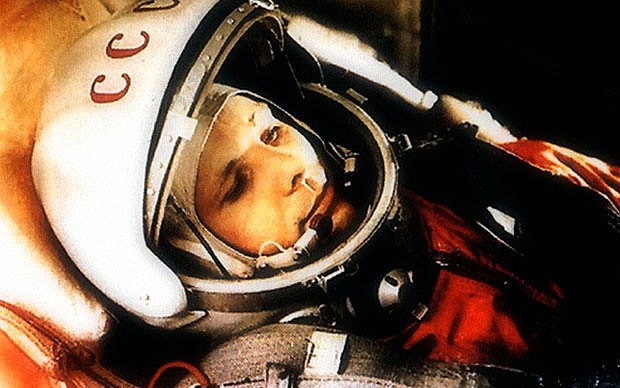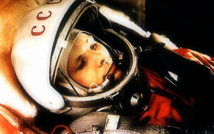"I see Vostok-6 quite often in the centre for cosmonaut training," she said.
"And every time I pass it by I stroke it and say "My lovely one, my best and most beautiful friend; my best and most beautiful man"."
Over 50 years later, she is still excited to pose in front of the capsule as it is displayed at the Science Museum, now dented and blackened due to being engulfed with flames as it entered the atmosphere.
Tereshkova, now aged 78, kept quiet on one of the best-kept secrets on space history: how she coped when she discovered she was sent into space without her toothbrush.
"I am very resourceful, as any woman would be," Tereshkova said with a mysterious smile.
Much more serious was a problem with the capsule on her return journey. Due to a programming error, it began to rise rather than to go down.
"That was a real mistake," she recalled. "I would have gone up and up instead of going down to Earth."
Luckily, ground engineers managed to fix the spacecraft's trajectory, and it began descending to earth at 27,000 kilometres an hour. Tereshkova jumped out in a parachute at 7,000 metres altitude.
The astronaut's treasured Vostok-6 is just one of several early spacecrafts displayed in the exhibition, "Cosmonauts: Birth of the Space Age".
Also on display are several Sputnik satellites and a lunar lander used to train cosmonauts how to land on the moon in a Soviet programme kept secret from the world until 1989.
- 'Never seen by Russians' -
In all, 150 objects are on display, from early Russian artistic impressions of space exploration to real space suits. Most have never been out of Russia before.
Often classified top secret for decades and many from private collections and archives, the collection demonstrates the initial supremacy of the Soviet Union in the 20th century space race.
"Many of these objects have never been seen by Russians," said Science Museum director Ian Blatchford.
It tracks the first satellite sent in orbit in 1957, the mission of Laika the dog the same year, followed by the first man in space, Yuri Gagarin in 1961, and the first woman Tereshkova, 20 years before the first US woman followed.
"We think that the first nation on the moon was Russia," Blatchford said, referring to the unmanned Luna 9, the first spacecraft to make a soft landing on the moon, in 1966.
"An incredible achievement, not given full respect," he said.
Alarmed by the progress of the Soviet Union, the United States pumped money into its space programme, and Moscow's efforts fell behind as its budget depleted and its chief designer, Sergei Korolyov, died unexpectedly.
The turning point came in 1969 when US astronaut Neil Armstrong became the first man to walk on the moon.
The Soviet Union turned its focus to space stations, and set new records, not least the longest time spent in orbit: the 803 days still held by Sergei Krikalyov.
On Krikalyov's first mission to the MIR space station in 1991, he was stranded for almost four extra months as the Soviet Union collapsed.
"Ground control continued to operate as normal," he recalled, his eyes filled with pride at the opening of the exhibition.
---------------------------------------------------------------------------------------------------------------------------
"And every time I pass it by I stroke it and say "My lovely one, my best and most beautiful friend; my best and most beautiful man"."
Over 50 years later, she is still excited to pose in front of the capsule as it is displayed at the Science Museum, now dented and blackened due to being engulfed with flames as it entered the atmosphere.
Tereshkova, now aged 78, kept quiet on one of the best-kept secrets on space history: how she coped when she discovered she was sent into space without her toothbrush.
"I am very resourceful, as any woman would be," Tereshkova said with a mysterious smile.
Much more serious was a problem with the capsule on her return journey. Due to a programming error, it began to rise rather than to go down.
"That was a real mistake," she recalled. "I would have gone up and up instead of going down to Earth."
Luckily, ground engineers managed to fix the spacecraft's trajectory, and it began descending to earth at 27,000 kilometres an hour. Tereshkova jumped out in a parachute at 7,000 metres altitude.
The astronaut's treasured Vostok-6 is just one of several early spacecrafts displayed in the exhibition, "Cosmonauts: Birth of the Space Age".
Also on display are several Sputnik satellites and a lunar lander used to train cosmonauts how to land on the moon in a Soviet programme kept secret from the world until 1989.
- 'Never seen by Russians' -
In all, 150 objects are on display, from early Russian artistic impressions of space exploration to real space suits. Most have never been out of Russia before.
Often classified top secret for decades and many from private collections and archives, the collection demonstrates the initial supremacy of the Soviet Union in the 20th century space race.
"Many of these objects have never been seen by Russians," said Science Museum director Ian Blatchford.
It tracks the first satellite sent in orbit in 1957, the mission of Laika the dog the same year, followed by the first man in space, Yuri Gagarin in 1961, and the first woman Tereshkova, 20 years before the first US woman followed.
"We think that the first nation on the moon was Russia," Blatchford said, referring to the unmanned Luna 9, the first spacecraft to make a soft landing on the moon, in 1966.
"An incredible achievement, not given full respect," he said.
Alarmed by the progress of the Soviet Union, the United States pumped money into its space programme, and Moscow's efforts fell behind as its budget depleted and its chief designer, Sergei Korolyov, died unexpectedly.
The turning point came in 1969 when US astronaut Neil Armstrong became the first man to walk on the moon.
The Soviet Union turned its focus to space stations, and set new records, not least the longest time spent in orbit: the 803 days still held by Sergei Krikalyov.
On Krikalyov's first mission to the MIR space station in 1991, he was stranded for almost four extra months as the Soviet Union collapsed.
"Ground control continued to operate as normal," he recalled, his eyes filled with pride at the opening of the exhibition.
---------------------------------------------------------------------------------------------------------------------------









 Home
Home Politics
Politics











